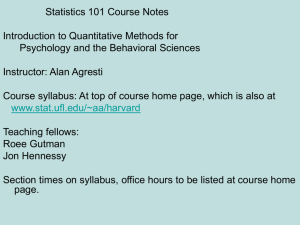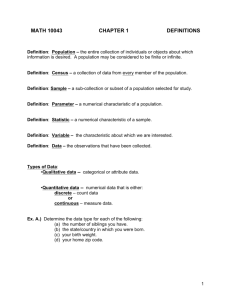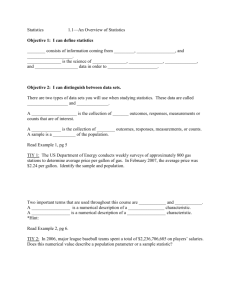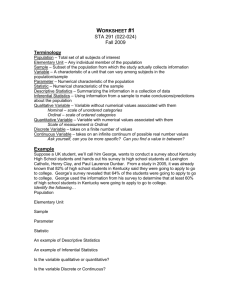Lecture Notes in Quantitative Biology L30a L30b Chapter 22.1 Revised 29 November 1996
advertisement
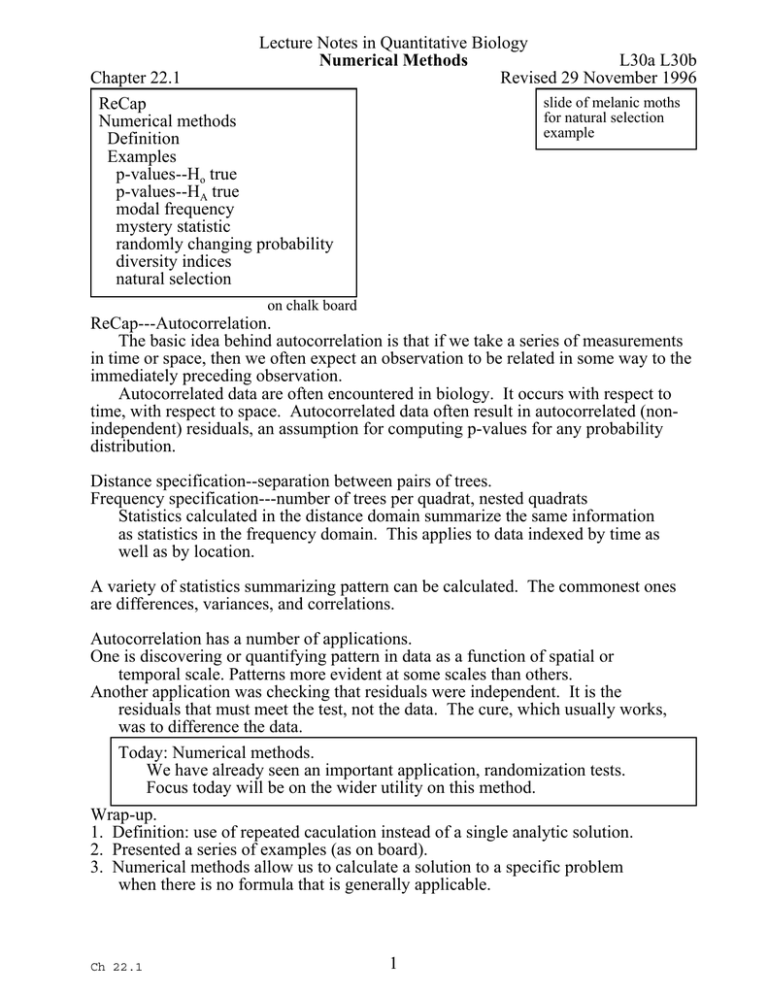
Lecture Notes in Quantitative Biology Numerical Methods L30a L30b Revised 29 November 1996 Chapter 22.1 ReCap Numerical methods Definition Examples p-values--Ho true p-values--HA true modal frequency mystery statistic randomly changing probability diversity indices natural selection slide of melanic moths for natural selection example on chalk board ReCap---Autocorrelation. The basic idea behind autocorrelation is that if we take a series of measurements in time or space, then we often expect an observation to be related in some way to the immediately preceding observation. Autocorrelated data are often encountered in biology. It occurs with respect to time, with respect to space. Autocorrelated data often result in autocorrelated (nonindependent) residuals, an assumption for computing p-values for any probability distribution. Distance specification--separation between pairs of trees. Frequency specification---number of trees per quadrat, nested quadrats Statistics calculated in the distance domain summarize the same information as statistics in the frequency domain. This applies to data indexed by time as well as by location. A variety of statistics summarizing pattern can be calculated. The commonest ones are differences, variances, and correlations. Autocorrelation has a number of applications. One is discovering or quantifying pattern in data as a function of spatial or temporal scale. Patterns more evident at some scales than others. Another application was checking that residuals were independent. It is the residuals that must meet the test, not the data. The cure, which usually works, was to difference the data. Today: Numerical methods. We have already seen an important application, randomization tests. Focus today will be on the wider utility on this method. Wrap-up. 1. Definition: use of repeated caculation instead of a single analytic solution. 2. Presented a series of examples (as on board). 3. Numerical methods allow us to calculate a solution to a specific problem when there is no formula that is generally applicable. Ch 22.1 1 Definition: Numerical methods substitute repeated calculations for a single analytic solution. The are used with increasing frequency, as the price of computing power drops, and the accessibility increases. Example. p-values Ho true The first example, by now familiar to us, is the use of "Monte Carlo" methods to calculate p-values. Ie to calculate the frequency (probability) of all outcomes more extreme than a particular observed outcome. We have a statistic measuring some pattern or some outcome from say an experiment. We wish to know whether this could have arisen by chance. We need to know the probability distribution of the statistic, due to chance. One solution is to assume that the probability fits one of the standard statistical frequency distributions: normal t F Chi-square Then calculate the p-value (chance of a more extreme value) from the cumulative distribution function cdf. This is the analytic solution. It is based on mathematical proof. Use this as opportunity for quick run thru concept of p-value from pdf and cdf. Draw pdf for X 2 then translate to cdf, Write Ho true in the distribution. Run arrows up from statistic X 2 to cdf then across to probability. Fig = L30a Another solution is to use a non-normal error structure (poisson, gamma, binomial, etc) within the framework of the generalized linear model. Yet another solution, if we cannot find an appropriate distribution, is to compute our own distribution of the statistic, from the data at hand. That is, we make the Ho true by randomizing the data, calculate the statistic, do this repeatedly, until we have a distribution to compute our p-value. This is a numerical solution. It has neither the generality nor elegance of a proof. It only works for the case at hand, which is usually all we need. Ch 22.1 2 Example -- modal value of the normal distribution The equation for the normal distribution of outcomes is: pdf(x) = xo exp(-(x-:)/F)2 We can use this to calculate frequency of observations at any value x At what value x does the normal distribution pdf(x) have a maximum ? If we look at the graph, it looks like the answer is that pdf(x) reaches its maximum when : = 0 and F = 1. Chance to review quickly the normal distribution, centred on zero. Fig = L30b Review also notation E(RF(X) = pdf(X) For a mathematician, the solution is of course to differentiate, set the derivative F'(x) equal to zero, and solve for x when the slope of the function itself is zero. Suppose were knew nothing about differentiation. With a little search, and the aid of a programmable calculator we can carry out a search for the right value. Search Table: x 10 5 !5 0 5 0.1 0.001 ________________________________________________________________ pdf(x) 10-44 10-11 10-11 1 10-11 .99005 .9999990 Search strategy was to start with a wild guess at x = 10, then take a guess downward x = 5, then a guess further downward at x = !5, then a point in the middle x = 0, then another guess in the middle x = 2.5, then an educated guess close to zero 0.1 then another educated guess close to zero 0.001. Ch 22.1 3 point at 10 on x axis beneath normal distribution Mark each guess on the xaxis below normal curve. Fill in the search table as each guess is made. Example modal value of a distribution (continued) Using numerical methods to search for location of the maximum value of the normal distribution. Iterative search shows that the closer to zero, the bigger the value of pdf(x). So the maximum value of pdf(x) occurs at pdf(0) ie at : This illustrates the use of numerical methods rather than analytic methods. Of course we would use analytic methods for this problem, by differentiating and solving for x. But in some cases analytic solutions cannot be obtained. Then numerical solutions are required. For example, Newton's laws of motion are used to compute weather change, but these are numerical solutions on large computers because the equations cannot be solved analytically. Example What is value of the mystery statistic ? Let Yi = 8 6 9 8 7 9 2 3 4 E(Yi - ST)2 = Dev2 What is the value of the mystery statistic ST that minimizes the squared deviations from ST ? What is the value of ST such that Dev2 has the minimum possible value ? Again, this can be solved analytically. In this case a little more difficult to set the problem up, but it can be solved by setting up a function, taking the first derivative, setting equal to zero, and solving for a. We can also approach the problem with direct computations. We write out a search Table of Dev2 as a function of ST, start with wild guesses for ST, move on to educated guesses, then finally make refined guesses as we home in on the value of ST that minimizes Dev2. If we carry this through by searching in this manner, we find that Dev2 reaches its minimum values when ST = mean(Y) Ch 22.1 4 Example. Randomly changing probabilities For standard statistical analyses we often have some theoretical distribution such as F, or t (a special case or F), or chisquare, or binomial, or normal. This is a theoretical function that gives us the precise value of the frequency of an outcome of a particular value x. For example if we have 7 successes out of ten trials we can use the binomial distribution to calculate the probability of obtaining this result if we had a 50:50 chance of success on each trial. The answer is p = 0.0547, which we know how to calculate in a spreadsheet or statistical package. MTB > cdf 7; SUBC> binomial n=10 p = .5 . This is an analytic solution. We can also use the analytical solution (the binomial distribution) if we know that we have a 30% chance of success on each trial. MTB > cdf 7; SUBC> binomial n=10 p=.3. Success is more elusive and so the probability of 7 success is much smaller. p = 0.0016 What if we had a situation where we knew that the chance of success changes from trial to trial? We cannot handle this with the binomial distribution, which has a parameter held constant, such as 50:50 in the first case, or 30:70 in the second. The analytic solution is to write an equation stating how this parameter changes from trial to trial, then solve for the distribtuion, then use this analytical solution to calculate p-values. This is difficult. It was the stuff of Ph.D. theses in statistics in the 1950s. The numerical solution to the problem is to carry out repeated applications of the binomial distribution for each trial, each with different parameter (obtained from random numbers between 0 and 1). Then keep of running tally of the number (or frequency) of success for 1 trial, 2 trials .... 10 trials. This produces an empirical distribution of outcomes, from which we can construct a cumulative distribution. If time allows, review how to construct cumulative distribution. Ch 22.1 5 Example Diversity index. A new example (grad project, Quentin Baldwin, in Winter 1995) Rarefaction formula for number of species. Can use numerical methods instead. No formula for effect on diversity index H = G pi ln pi where p = proportion of species i in collection of size N So use numerical methods to investigate this. Ch 22.1 6 Example Natural Selection. This material can also be used for last quiz, see Lastquiz.w13 WP file. This quiz is example of problem solving, in format that is relatively easy to mark, and so makes good final exam question. The quiz can be given in the final days, then marked in class, as a form of review. People do not like to mark other quizzes, so it is best to have each person mark their own quiz, which they can retain for review. Here is another example of substituting calculation for analytical solution. Taken from R. Dawkins The Blind Watchmaker Picture of melanistic moth on screen, if possible. With brief recap of selection for dark coloration due to soot on trees in England, beginning with the industrial revolution. We are confronted with skilfully designed artifact, such as a watch lying out on the moor. We say then that this artifact is so improbable that it must have been fabricated by some watchmaker. We then look at the exquisite design of an organism and reasoning similarly, ask the nature of the watchmaker. Can natural selection, acting blindly, be the watchmaker ? The complexity of the end result would seem to argue against there being a blind watchmaker. Natural selection is blind, and so couldn't make such an exquisitely designed watch. This turns out be be true if we try to assemble the artifact all at once, rather than from completed subunits. To show how effective cumulative natural selection can be we will construct a sentence by natural selection. "Methinks it is like a weasel" What is chance of this ? there are 28 places to fill, with 26 letters or blanks. Construction by chance is 1 in 27 to the 28th power. Chance of this sentence being constructed by single step selection is 1 in 1040 or so. Very improbable. Let's calculate outcomes using "cumulative selection" Start with 28 random letters Replicate the sentence with certain chance of mistakes (typically 1 in 106) Select copy closest to pattern sentence. Using this selected copy, repeat the process. Ch 22.1 7 Example Natural Selection. (continued) How many steps to get perfect adaptation ? (Ie to get the target sentence) Dawkins wrote a program to do this 1 run 43 steps next run 64 steps next run 41 steps Rather less than 1040 steps. This is an example of solution by numerical rather than analytical methods. Dawkins used a series of computations according to his concept of sequential selection to arrive at an answer. The answer was "around 50 rather than 1040" The answer was not obtained from an equation. Dawkins goes on to more complex set-up of the problem in which computer grows "trees" (organisms) according to certain recursive rules (genes). Results are counterintuitive. The trees were far more complex than one would expect, just using random mutation + selection relative to template of the environment. When analytic solutions fail due to complexity of the problem, then numerical methods become necessary. Numerical methods produce answers when analytic solution fail. The bonus in using these quantitative methods is that they will often serve to sharpen our thinking, as they force us to state the problem in some exact fashion, exact enough to make calculations. Ch 22.1 8 Wrap-up. Examples: Monte Carlo estimates of p-values Finding an optimum (maximum) value E.g. "mystery statistic" (the mean, minimizes squared deviations) E.g. Finding "best" cladistic tree Computing fluid flows, using Newton's laws Computing genetic combinations Rate of evolution by assembly of subunits there are many good recipes in quantitative biology, based on analytic formula. Best to use these when available. but if none are available, computation methods can be used. These allow us to calculate a solution in a specific case, when there is no formula that is generally applicable. Ch 22.1 9
